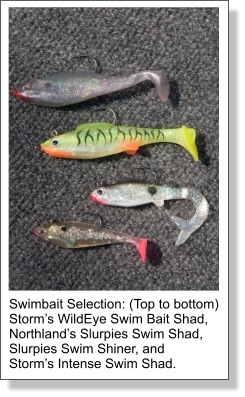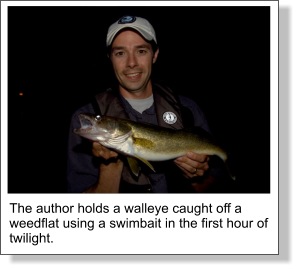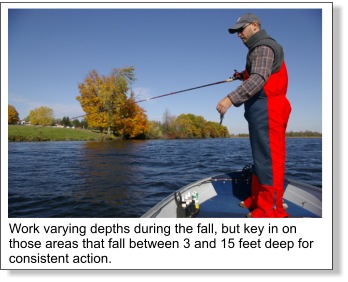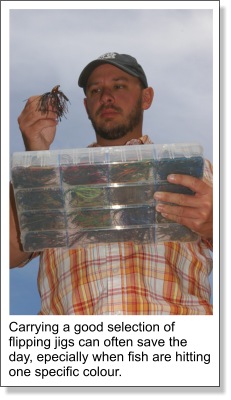 Swimbaits
for Walleye Swimbaits
for WalleyeBy Tim Allard If you’re looking to land big walleye and prefer casting over trolling, swimbaits are one of the best baits going to accomplish this goal. When other anglers are working small, twister tail jigs with a vertical finesse approach, casting a swimbait can boat you plenty of fish. This season give yourself an advantage, integrating swimbaits into your walleye repertoire. Here’s what you need to know about these productive baits.  Styles
of Swimbaits Styles
of SwimbaitsThere are two main varieties of swimbaits popular with walleye anglers. One style is unrigged bodies teamed with darter, bullet or shad style jig heads anywhere from ¼- to ½-ounces. Examples include Berkley’s PowerBait Hand Pour Swim Shad, YUM’s G-Shad or Samurai Shad, Mister Twister Sassy Shad, and Northland’s Mimic Minnow Shad. For the best action these baits must be rigged straight. Adding a drop of soft-bait glue to the head of the bait before pushing the plastic tight to the jig head keeps bodies properly rigged, even after landing a few fish. Another type of swimbait style doesn’t require rigging. They feature soft-plastic bodies poured around an internal lead head and hook. Examples include Storm’s WildEye Swim Shad, YUM’s Sweet Cheeks, Northland’s Slurpies Swim Shad, and Berkley’s PowerBait Swim Bait. These style of swimbaits come pre-rigged in packs. Simply tie them on and start fishing. The Anatomy of a Swimbait Typical swimbaits for walleye range in size from three to six inches. Compared to thin twister tail grubs, swimbaits provide a more robust profile resembling a hearty meal as opposed to a small morsel. From head to tail, swimbaits offer a level of realism few baits can duplicate. Even the most natural paint job on a crankbait can’t hide the fact it’s a hard-bait; swimbaits squish in a walleye’s mouth like a soft candy. Many are often juiced up with fish attractant or scent, encouraging fish to hold on once they grab a bait. The natural colour patterns on swimbaits help anglers “match the hatch”, which is important in clear water systems. Bright colour patterns are available as well for turbid water or during low-light conditions. Internal holographic materials are standard in many swimbaits, producing an iridescent lustre for added attraction. Tempting Tails Paddletails are predominant on swimbaits. During retrieves these wide appendages wobble, moving water and putting out plenty of vibrations. The flat sides reflect light as the tail wiggles, mimicking the flicker from swimming baitfish. Regardless of the speed, paddletails add a no-nonsense walleye-attracting action to swimbaits. Curly or flat, tapered tails are the other options available on baits. Their design delivers a tighter, seductive saunter to baits in comparison to paddletails. Fish Them on Flats Although there are no wrong places to cast swimbaits, there are spots where they are more effective than others. Flats are one such area. Swimbaits excel at covering water when searching for walleyes. This makes them a prime bait for flats whether comprised of rocks, sand, or mud. I often use a 3/8-ounce swimbait with a casting outfit spooled with 30-pound test superline on flats. The rod’s power lets me cast them a considerable distance to cover large flats without getting fatigued.  Work
them in Weeds Work
them in WeedsWalleye relate to weeds for shade, but more importantly they’re there for food. Whether ambushing perch or gorging on various aquatic insects, walleye are often willing to bite when you find them in weeds. The up-facing hook on swimbaits makes them ideal for skimming over the top of weeds. You also can’t go wrong casting a swimbait along the edge of a weedline near a drop off. Concentrate on the edge but make occasional tosses to deeper water. Use the castability of the bait to your advantage and work the entire area until you start contacting fish. Walleye may be in the weeds, but they may also be hanging off the break waiting to invade the underwater forest come dusk. Be on the look out for bays, points, cuts, and old stream beds. These ones concentrate walleye and serve as route ways for their daily migrations. Don’t Overlook the Classics Although flats and weed areas are two of my top spots to cast swimbaits, there are many other classic walleye areas where these baits produce fish. In essence, anywhere you’d consider working a jig and grub can be dynamite for swimbaits. Rocky structures such as reefs, humps and points are prime locations. In most instances reeling baits in a foot or so off bottom will catch fish on these zones. Yet, like weed edges, make occasional casts to the surrounding deeper water. Swimbaits are taking the angling world by storm for a variety of species. If your walleye tackle box doesn’t have a space reserved for swimbaits, you’re missing out on an effective presentation. Give swimbaits a dip this season and put more head-turning walleye in your boat. Photos by Tim Allard Dusk Walleye: the author holds a walleye caught off a weedflat using a swimbait in the first hour of twilight. Swimbait Selection: (Top to bottom) Storm’s WildEye Swim Bait Shad, Northland’s Slurpies Swim Shad, Slurpies Swim Shiner, and Storm’s Intense Swim Shad.. A Time of Change As summer transitions into fall, a series of changes begin to take place. Bright crimson hues take hold of flag-waving leaves, while lake water begins to slowly dip in temperature. The pesky biting bugs have all but disappeared, as have the fair-weathered weekend warriors. But a change is also occurring within the resident largemouth. Sensing the impending arrival of the winter food drought and dormant stage, bass are beginning to feed heavily, bingeing on prey and rapidly building up fat reserves. Location is Key If I could have one common ingredient when chasing fall largemouth, it would definitely be the presence of rock. The reason behind this is two-fold. Crayfish are an integral part of the largemouth diet. And what better place to find these high caloric snacks than in the place they call home. The other important factor is heat. Acting like a magnet in attracting and holding the skyward sun, rocks provide a thermal layer of warmer water that largemouth bass instinctively gravitate to. Rock comes in all shapes and sizes, but over the years I've found a few variables that are worth keying in on. Slab rock is one. These large stone "tables" will often find fish holding on top, or just off the edge where it meets deeper water. A collection of boulders, pebbles, slab, and chunk are also prime real estate pieces. Wood, in conjunction with rock, is also a target when seeking out fall bass. Although large laydowns will frequently hold fish, I've found that the mere presence of a stick or branch is enough to attract and hold a fish on a spot. Docks that are situated over deep rock are another favourite structure area, and often harbour big fish within their secretive lair. Where To Start  Deep-water lakes make prime candidates for fall largies, whereas shallow, fertile lakes are generally a poor choice. Many of my top lakes average 60 to 100-feet deep, and are almost entirely made up of rock and rubble. Start with shorelines that drop into deeper water fairly quickly. The kind that has the boat twenty-feet from shore and the sonar reading 30-feet deep. It is then a matter of working your way around a lake, seeking out areas that were discussed previous, and pounding them into submission. There is no perfect depth for finding largemouth in the fall, but if I could narrow it down, I would put my most effort into water that fell between three and 15-feet deep. Don't dismiss those warm days that routinely crop up in September and early October. Although still classed as fall time, some of my better days have been when the sun has shone and the shorts came out. Sunny days will often find fish shallow - especially in chilly weather - while rough or stormy days see them drop a bit deeper.  All
Hail to the Flipping Jig All
Hail to the Flipping JigNo other lure has accounted for more, or bigger largemouth bass come fall than the flipping jig. My favourite style of bait is a ½ ounce model. Deep water or rough and windy conditions will dictate the use of a heavier jig, at which point switching to a ¾ ounce bait is recommended. Brown, brown/orange, brown/black, and red/black are my top colour choices, although I have also had success with blue, black, and purple. Rattles are an integral part of the system, so make sure your jig is capable of making sound. I rely quite heavily on plastics as trailers, and find that craw chunks in the 3-½ inch size fit my needs perfect. Although my "go-to" combination consists of a Booyah "Boo Jig" and Yum Chunk, other models made by Berkley, Strike King, and Zoom also fit the bill. The technique I employ during the fall is quite simple. Twenty to thirty-foot casts or pitches are the norm, and unless targeting a specific structure point, accuracy is not a necessity. Allow the jig to fall completely to bottom. Reel up the slack, and proceed to slowly drag or hop the bait back to the boat, making sure to maintain contact with the structure you are fishing.  Fish will hit a jig in a number of different ways. If they are very aggressive, you will feel a definite "pop" on the end of your line. They may hit it with a "tap, tap, tap" sensation. The last way is for them to mouth the bait and slowly swim off. This is easy to distinguish, as you will feel a dead weight and your line will begin moving off to the side. Whichever the case, rearing back on the rod with all your might is mandatory. Heavy flipping gear is the name of the game when working the rocks. I prefer a Kistler LTX 7'6" heavy action flipping stick. As for line, 20 or 25lb clear monofilament line on a smooth and dependable baitcast reel works for me. For those into braid, choose a test strength in a matching diametre. Fall time is one of splendour. The scenery is breathtaking and the bass run big, and for all of us trophy hunters, there is no better time of season to reap the phenomenal rewards. Thanksgiving indeed.
In This Issue Swimbaits for Walleye | Eating Your Catch - From Landing Net to Table Become an Outdoor Writer! | Readers Pictures | Product Showcase unHookem Hook Removers Get North! Stressed? need a vacation? -Visit Get North to find your Northern Ontario get-away! Fishing Lodge Classifieds -Come fish your heart out at one of these many Lodges, Camps and Resorts. Archived Articles - Click here to see articles from past E-Magazines
|

